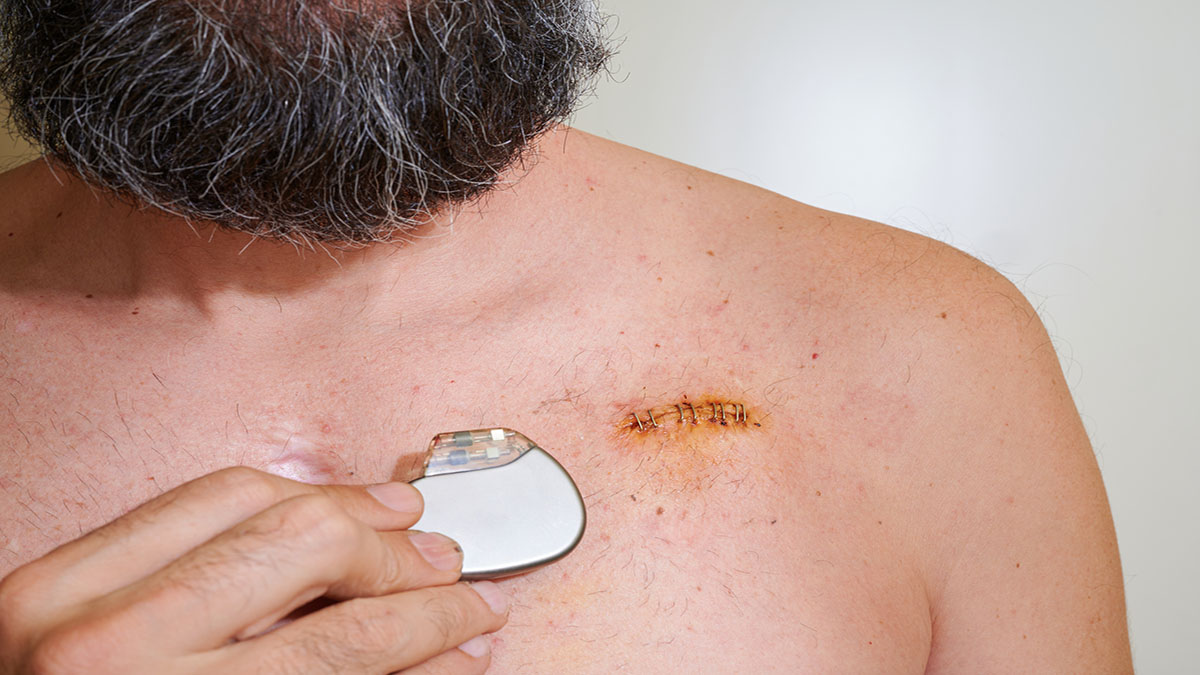Insights into Allergy and Implanted Cardiac Devices: Part 2 - Treatment

Patients with allergies to certain metals and compounds can make safely treating them challenging. Dr. Tom Callahan and Dr. Bruce Wilkoff speak with Dr. John Anthony, Dermatology, and Dr. James Taylor, Clinical Professor of Dermatology, regarding treatment plans for patients with allergies to compounds in implantable cardiac devices.
Interested in learning more about lead management? Visit: https://leadconnection.org
Subscribe: Apple Podcasts | Podcast Addict | Buzzsprout | Spotify
Insights into Allergy and Implanted Cardiac Devices: Part 2 - Treatment
Podcast Transcript
Announcer:
Welcome to Cleveland Clinic Cardiac Consult, brought to you by the Sydell and Arnold Miller Family Heart, Vascular and Thoracic Institute at Cleveland Clinic.
Thomas Callahan, MD:
Welcome to the LEADConnection podcast where we talk about everything related to lead management. I'm Tom Callahan, and I'm joined by Dr. Bruce Wilkoff, one of the founders of LEADConnection, Dr. John Anthony, who's section head of Occupational and Contact Dermatology at Cleveland Clinic, and Dr. Jim Taylor, clinical professor of dermatology at Cleveland Clinic Lerner College of Medicine. Welcome, everyone.
John Anthony, MD:
Thank you.
Bruce Wilkoff, MD:
Thank you.
Thomas Callahan, MD:
It's very difficult to predict who's going to have these reactions, and then it's very difficult to confirm the diagnosis. So, a lot of challenges here. But how about treatment? Let's say we're pretty confident that this patient has a reaction. Is there at least good news on the treatment front?
John Anthony, MD:
This is also a frontier, because when you look at treatment of metal allergies, there's a lot written about incidence and a lot of these devices are explanted. How it makes it into the paper, we had this problem, we explanted, the patient got better. It must have been the device. The only treatments that are really described are steroids, but that's sort of suboptimal. If you're going to leave a device in, how long are you going to need to treat with steroids to enable the patient to tolerate it? I think that's not necessarily the best option for a lot of our patients. There are probably sporadic case reports using a variety of things. There's one report of reaction to a nickel-containing stent that responded to dupilumab, so that at least suggests, possibly, of moving forward. But that's an off-label use, of course, single report.
I think that in the orthopaedic realm, I have tried, although I haven't seen many patients and I really can't report on how effective it's been, but when the patient doesn't want to have their joint explanted, but they seem to be allergic, I've tried some other immunosuppressives, and I think we see maybe some early results that could be useful. I don't know if that's generalizable. And of course, those have their own downsides. You have to have a patient who's willing to keep their implant, where the explantation is not a great option for them, and if there's not a great alternative device, then maybe trying some of these anti-rheumatologics immunosuppressives might be useful. Jim, I don't know if you have any thoughts. Or Bruce, I don't know.
Bruce Wilkoff, MD:
Yeah, no. Are you talking like methotrexate or are you talking about, what are you talking about in terms of immunosuppressives?
John Anthony, MD:
Methotrexate is something that we in derm have a fair amount of experience in our psoriasis patients, so that would probably be a starting point for some patients, if mycophenolate mofetil would potentially be an option. Although, again, none of these have really been studied, so I really can't say how effective they might be. But in those patients where the explantation is just not a great option or because of other patient factors, I think we should be open to at least offering some of these for our patients.
James Taylor, MD:
To go back to the question of nickel, one interesting thing is that, in addition to the hypersensitivity that we see, which is typically delayed, it could also can be immediate, so urticarial reactions have been reported. In regard to the delayed hypersensitivity or allergic contact dermatitis, systemic nickel allergy has been reported in some cases, and it's been shown, actually, in some studies, that if you have orthodontia prior to ear-piercing, that your probability of nickel allergy is less. In some of the cases with systemic reactions to these devices, low-nickel diets have been reported and the use of chelating agents, such as EDTA, which I personally have not used, and then the other is disulfiram, which is used for treating alcoholism, which is a rubber-related substance that produces a reaction if you drink alcohol. That has been used, again, in some cases with nickel allergy, especially if you've got a systemic reaction to nickel where you've got disseminated rash or you have what we call dyshidrosis or vesicles or blisters on the palms, that can be helped by a low-nickel diet. There's nickel in specific foods and more so than others. That's well documented and well published.
Bruce Wilkoff, MD:
Let me ask a question here. So, it's my perception that nickel allergy is very common. So, from this discussion, we might be very worried about it. If allergy is vanishingly rare, allergy to a device, yet every single pacemaker lead, defibrillator lead is an alloy, which includes nickel, the nickel actually provides the flexibility. I once had a patient that we were convinced to had a nickel allergy that was causing a problem or thought it was, and I had a pacemaker lead made for me that had no nickel in it. But the problem was, is that if you took the lead and you bent it, it stayed that way. It's no longer a spring. And it worked. I couldn't have an active fixation lead, I got it to work, and the person did well, in the N of one. So if you could talk about, what is the incidence of significant nickel allergy? And then we can talk about, what I'm going to tell you is a vanishingly rare type of thing of allergy that could manifest from an implantable device. Could you talk about that a little bit?
James Taylor, MD:
Well, nickel allergy in the general population is common and it varies. Prevalence of large groups of patients that are routinely patch tested for dermatitis of any kind, punitive allergic contact dermatitis from anything, series will show that anywhere from 15-25 percent of patients that are patch tested have positive reactions to nickel. And then when you consider the other more common allergens, so cobalt would be next and would be lower, maybe 10 percent, and then we get into chrome, maybe 5 percent or so, and any other metals are clearly much less.
Bruce Wilkoff, MD:
So, it's really common in people, but obviously that's translate to risk of a device.
James Taylor, MD:
Correct. What I was going to say, it's not the content that's important, well, as much as the release, that's important. And that's been well documented with the AMPLATZER devices, for instance, and related devices used for patent foramen ovale and atrial septal defect occlusion and there are devices now that have much less nickel release and apparently are used in instead. So, again, it's the release and not the content as much. With orthopaedic devices, it's been well documented that many patients with nickel allergy don't have problems long term in Europe, and we try to encourage it here in the United States to not do routine pre-op patch testing unless there is a definite history of nickel allergy, John.
John Anthony, MD:
A couple of points too. I think we all know that patient self-report of metal allergy is not a great reliable indicator. It doesn't correlate very well with patch testing results. So it's something that we need to consider, but it doesn't always indicate, it's probably not sufficient to diagnose. And really, Bruce, this is the crux of the problem. How do you predict who is going to have a problem with the device? To date, I don't think we know. We know that occasionally people do, so the presence of a nickel allergy patch test positive probably increases your risk of complication, but it doesn't mandate a risk. It doesn't suggest that you will have a problem. This applies to other cardiac and neurologic devices that are composed, especially the AMPLATZER that's Nitinol. So sometimes you have a documented metal allergy, like nickel, and that a device contains it. And so, people come to me and they're like, can I have this TAVR done? Can I have this AMPLATZER done? The counseling has to be, well, okay, you probably have an increased risk of a complication, which might be systemic and might possibly be treatable or might require explantation. But what's the alternative? The alternative is sometimes not too pretty. Do you have a TAVR? Do you have an open valve replacement? For some patients, the choice is so far weighted towards having the TAVR done that, probably, the risk out is outweighed. Even though if you read the packaging, it says, don't use this device if there's an allergy to a component. I feel like that's the crux of the problem, and that's why, unfortunately, when I'm having these discussions with patients, I know Jim is the same, we always couch in terms of, these aren't absolute contraindications. They have to be considered within the context of what are the risks of not having the procedure done or the alternatives.
Bruce Wilkoff, MD:
That makes sense. I agree with you. The real question that we have. Afterwards is one problem, but how do you counsel patients who think they're allergic to things. And thoughts are very strong. They dominate our interactions with our patients and it’s a very important issue. Thank you.
Thomas Callahan, MD:
Right. Yeah. And very often for pacemakers and defibrillators, there really isn't another option for patients with complete heart block, for instance. The only option, really, is the pacemaker. So it can be a challenge. Well, this was a great conversation. I want to thank both of you for Dr. Taylor and Dr. Anthony for joining us. Really insightful. Thank you so much for your time and insights.
John Anthony, MD:
Thank you so much. I appreciate the opportunity.
James Taylor, MD:
Likewise. Thank you, Tom and Bruce.
Thomas Callahan, MD:
All right. Until next time.
Bruce Wilkoff, MD:
Bye-bye.
Announcer:
Thank you for listening. We hope you enjoyed the podcast. We welcome your comments and feedback. Please contact us at heartccf.org. Like what you heard? Subscribe wherever you get your podcasts, or listen at clevelandclinic.org/cardiacconsultpodcast.

Cardiac Consult
A Cleveland Clinic podcast exploring heart, vascular and thoracic topics of interest to healthcare providers: medical and surgical treatments, diagnostic testing, medical conditions, and research, technology and practice issues.



